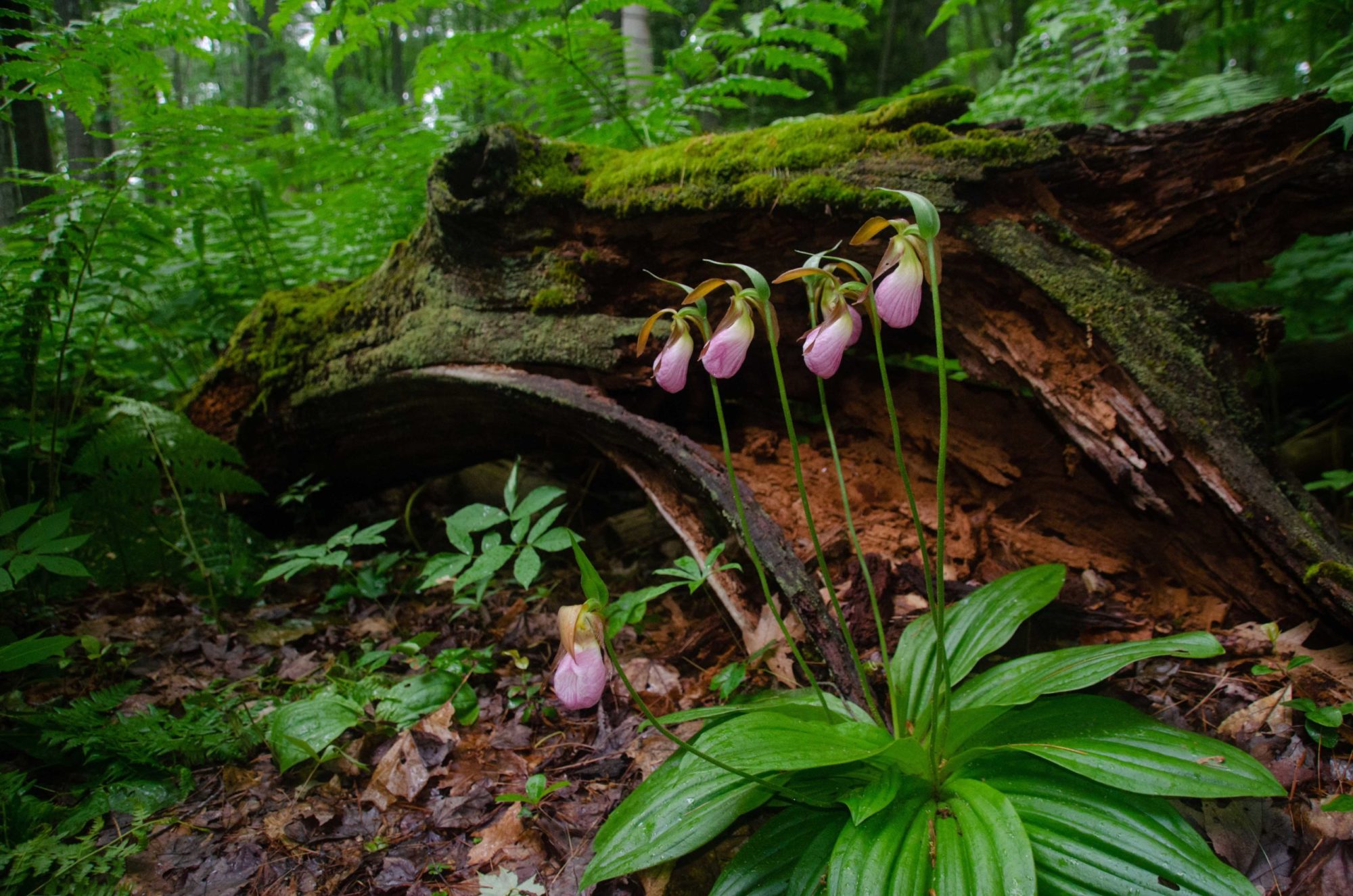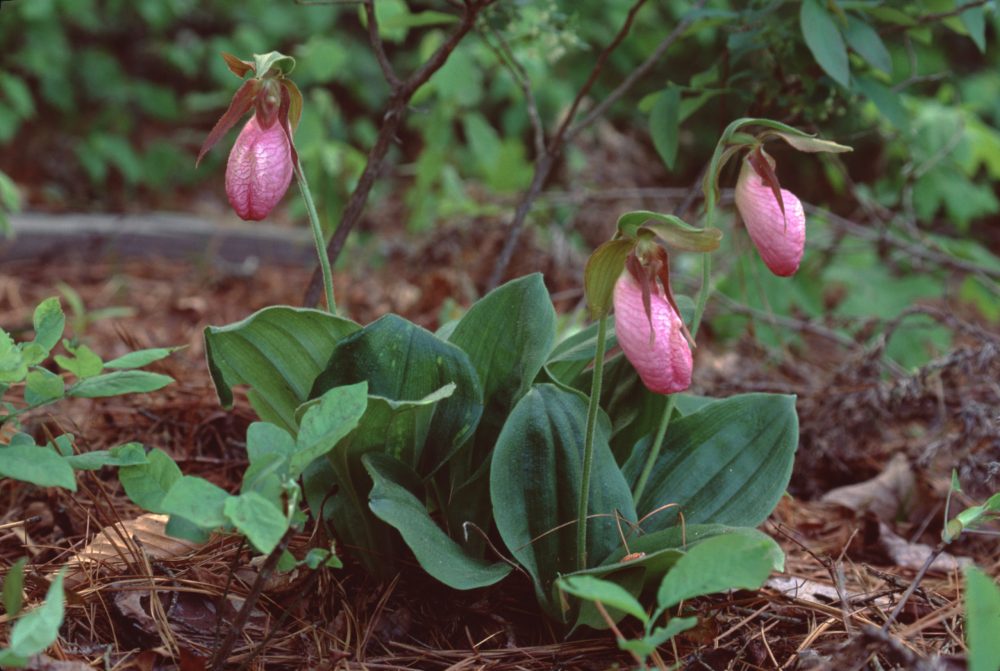Orchids Native to the Blue Ridge Mountains

by Amanda Hastings, former Ecotour Guide for Asheville Hiking Tours
Want to observe exquisite orchids in their wild, natural environment, yet not quite ready to book a trip to the tropics or a remote island somewhere? Many may be shocked to learn these enchanting plants live in a variety of environments outside of tropical rainforests or greenhouses, such as mature woodlands in the mountainous Southeastern United States! The Southern Appalachian Mountains are one of the most biodiverse temperate regions of the world and home to a total of 52 described orchid species. In this article, you will find descriptions of 6 species that can be found specifically along the Blue Ridge Parkway near Asheville, NC, nested in the Blue Ridge Province of the Southern Appalachians.
Orchids are often times described as rare or difficult to find. In actuality, these plants can be quite numerous, but require a trained eye to spot them. Many orchids are particularly sensitive to changes in their habitat, meaning they can be abundant one year and fairly scarce the next year in the same location. Finding a native orchid in the wild depends upon location, timing, opportunity, and perseverance. Sounds like too much work? Rest easy! Trained naturalists and tour guides spend countless hours researching this kind of stuff so they can show you these mesmerizing plants (along with other local flora and fauna) on a guided hike. Asheville Hiking Tours, for example, provides ecotours of some of the best-kept “secrets” of the Southern Appalachians, including stunning waterfalls, scenic mountain views, wildlife sightings and more! Grab your camera, rain jacket (always a good idea in the Southern Appalachians), perhaps a journal, and prepare for an entertaining and educational experience with Asheville Hiking Tours’ naturalists.
Now, before you take to the trail… note! Please never collect wild orchids. These plants form a special bond with symbiotic fungal partners in the soil, making successful transplantation nearly impossible. With preservation in mind, remember the presence of native orchids supports the natural balance of the entire ecosystem in which they are found. By leaving these elegant flowers just as they are and where they are, you preserve the opportunity for our future generations to admire their beauty. If that isn’t incentive enough, many wild orchids inhabit lands protected by the state and federal governments or environmental non-profits, such as The Southern Appalachian Highlands Conservancy. Try to mess with these beauties and you could end up with a hefty fine.
While there are more native orchids of the Blue Ridge Mountains than we discuss here, the following list includes those orchids that inhabit lands near Asheville, NC and are amongst the “easier” to identify orchids with pronounced diagnostic features. Other native orchids found along the Blue Ridge Parkway include: the yellow fringed orchid, the ragged fringed orchid, the lily-leaved twayblade, Loesel’s twayblade, green adder’s mouth orchid, and more (Bentley 31-32).
1. Lady’s Slipper Orchids (Cypripedium)
There are eleven species within this genus throughout North America, five of which inhabit the Southern Appalachian Mountains. Lady slipper orchids are slow-growing plants, requiring sometimes 3 to 4 years to develop from seed to full maturity (Bentley 90). For each member of this genus, the leaves are ribbed or veined. The most distinguishable characteristic of lady slipper orchids is the lip, or lower petal, of their flowers (Bentley 91). The lip resembles a “slipper” or pouch and gives each species its distinct color.

Pink Lady’s Slipper Orchid
Pink Lady’s Slipper (Cypripedium acaule)
The pink lady’s slipper, or pink moccasin flower, is one of the most unique in its genus and among the more widely known Southern Appalachian wildflowers. Unlike most lady slippers, the pink lady slipper is a single-flowered plant with paired basal leaves and a bare stem. Its single pink to purple inflated lip, or “slipper,” has a vertical slit in the center where pollinators (often the bumblebee) enter the flower (Bentley 93). The size of a flowering plant can be highly variable and depends upon habitat type. In the southern extent of its range, Cypripedium acaule prefers strongly acid conditions, yet prefers more basic soils in the North. The flowering period spans mid-April in lower elevations to mid-June in higher elevations in the southern mountains (Bentley 95). The pink lady slipper is postulated to inhabit every county of the Southern Appalachians.

Yellow Layd’s Slipper Orchid
Yellow Lady’s Slipper (Cypripedium parviflorum)
Cypripedium parviflorum, or yellow lady’s slipper, is especially striking with a vibrant bulbous yellow slipper, sometimes with small red spots inside. Diagonally along the stem, strongly veined leaves climb overtop of one another. With just a slightly narrower flowering period compared to the pink lady’s slipper, this species blooms between late April to mid-June. Flowering plants reach a height around 12-15 inches (30-38 cm) with often two waxy slippers posed atop the stem (Bentley 103). On occasion, some plants will have three! Similar to the pink lady’s slipper, Cypripedium parviflorum has adapted to drier, more acidic conditions in the Southern Appalachians.
